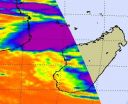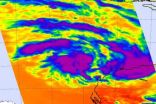(Press-News.org) While governments debate about potential policies that might curb the emission of greenhouse gases, new University of Washington research shows that the world is already committed to a warmer climate because of emissions that have occurred up to now.
There would continue to be warming even if the most stringent policy proposals were adopted, because there still would be some emission of heat-trapping greenhouse gases such as carbon dioxide and methane. But the new research shows that even if all emissions were stopped now, temperatures would remain higher than pre-Industrial Revolution levels because the greenhouse gases already emitted are likely to persist in the atmosphere for thousands of years.
In fact, it is possible temperatures would continue to escalate even if all cars, heating and cooling systems and other sources of greenhouse gases were suddenly eliminated, said Kyle Armour, a UW doctoral student in physics. That's because tiny atmospheric particles called aerosols, which tend to counteract the effect of greenhouse warming by reflecting sunlight back into space, would last only a matter of weeks once emissions stopped, while the greenhouse gases would continue on.
"The aerosols would wash out quickly and then we would see an abrupt rise in temperatures over several decades," he said.
Armour is the lead author of a paper documenting the research, published recently in the journal Geophysical Research Letters. His co-author is Gerard Roe, a UW associate professor of Earth and space sciences.
The global temperature is already about 1.5 degrees Fahrenheit higher than it was before the Industrial Revolution, which began around the start of the 19th century. The scientists' calculations took into account the observed warming, as well as the known levels of greenhouse gases and aerosols already emitted to see what might happen if all emissions associated with industrialization suddenly stopped.
In the best-case scenario, the global temperature would actually decline, but it would remain about a half-degree F higher than pre-Industrial Revolution levels and probably would not drop to those levels again, Armour said.
There also is a possibility temperatures would rise to 3.5 degrees F higher than before the Industrial Revolution, a threshold at which climate scientists say significant climate-related damage begins to occur.
Of course it is not realistic to expect all emissions to cease suddenly, and Armour notes that the overall effect of aerosols – particles of sea salt or soot from burning fossil fuels, for example – is perhaps the largest uncertainty in climate research.
But uncertainties do not lessen the importance of the findings, he said. The scientists are confident, from the results of equations they used, that some warming would have to occur even if all emissions stopped now. But there are more uncertainties, and thus a lower confidence level, associated with larger temperature increases.
Climate models used in Intergovernmental Panel on Climate Change assessments take into consideration a much narrower range of the possible aerosol effects, or "forcings," than are supported by actual climate observations, Armour said. The Nobel Peace Prize-winning panel, sponsored by the United Nations, makes periodic assessments of climate change and is in the process of compiling its next report.
As emissions of greenhouse gases continue, the "climate commitment" to a warmer planet only goes up, Armour said. He believes it is helpful for policy makers to understand that level of commitment. It also will be helpful for them to understand that, while some warming is assured, uncertainties in current climate observations – such as the full effect of aerosols – mean the warming could be greater than models suggest.
"This is not an argument to say we should keep emitting aerosols," he said. "It is an argument that we should be smart in how we stop emitting. And it's a call to action because we know the warming we are committed to from what we have emitted already and the longer we keep emitting the worse it gets."
###
The paper was published in the Jan. 15 edition of Geophysical Research Letters.
For more information, contact Armour at 858-610-3812 or karmour@uw.edu, or Roe at 206-697-3298 or gerard@ess.washington.edu.
If greenhouse gas emissions stopped now, Earth still would likely get warmer
2011-02-16
ELSE PRESS RELEASES FROM THIS DATE:
Peer support offers promise for reducing depression symptoms
2011-02-16
Peer support offers promise as an effective, low-cost tool for fighting depression, a new study by the VA Ann Arbor Healthcare System and University of Michigan Health System finds.
Programs in which patients and volunteers share information were found to reduce symptoms of depression better than traditional care alone and were about as effective as cognitive behavioral therapy, researchers found after analyzing 10 randomized trials of peer support interventions for depression dating from 1987 to 2009.
The analysis was the first of its kind to look at peer support specifically ...
4.7 million Californians to gain coverage under health reform, new study estimates
2011-02-16
Up to two-thirds of California's 7 million uninsured residents will become eligible for health insurance coverage when health care reform is implemented in 2014, according to a new policy brief from the UCLA Center for Health Policy Research.
The study draws on the latest data from the California Health Interview Survey (CHIS), which will be released shortly.
The policy brief, "Two-thirds of California's 7 Million Uninsured May Obtain Coverage Under Health Care Reform," finds that 4.7 million Californians, including both adults and children, will likely be eligible ...
Payoffs of long-term investment in education research
2011-02-16
WASHINGTON, D.C.—Leading scholars and private foundation presidents shared the Capitol Hill stage to highlight the payoffs of long-term investment in education research at a Capitol Hill briefing on Monday, February 14, 2011. Speakers emphasized that education research based on long-term funding has led to important payoffs for education policy and practice in such areas as resource allocation, school and classroom organization, and the education and evaluation of teachers.
The Education Deans Alliance, American Educational Research Association, and the National Academy ...
NIH-funded study finds new possible risk factor of heart disease
2011-02-16
Abnormal heart rate turbulence is associated with an increased risk of heart disease death in otherwise low-risk older individuals, according to a study funded by the National Heart, Lung, and Blood Institute (NHLBI), part of the National Institutes of Health.
This study appears in the Feb. 15 edition of the Journal of Cardiovascular Electrophysiology.
Among the nearly 1,300 study participants, heart rate turbulence, which reflects how well the heart reacts to occasional premature contractions, was an even stronger heart disease risk factor than elevated levels of C-reactive ...
Designing new molecular tools to study the life and death of a cancer cell
2011-02-16
Basic and translational research on cancer, and development of new cancer therapeutics, has focused on different aspects of cancer cellular function. One area of focus is the life and death of a cancer cell. Apoptosis, also known as programmed cell death, is a fundamental process of cells including cancer cells. The signal transduction pathways of apoptosis involve many different proteins and their interactions with each other. Protein-protein interactions involved in these apoptotic signals, like those in many other biological processes, are often determined or influenced ...
Astronomers identify thick disc of older stars in nearby Andromeda galaxy
2011-02-16
An international team of astronomers has identified for the first time a thick stellar disc in the Andromeda galaxy, the nearest large spiral galaxy to our own Milky Way.
The discovery of the thick disc, a major result from a five-year investigation, will help astronomers better understand the processes involved in the formation and evolution of large spiral galaxies like ours, according to the team, which includes UCLA research astronomer Michael Rich and colleagues from Europe and Australia.
Using the Keck Telescope in Hawaii, the astronomers analyzed the velocities ...
Overabundance of protein expands breast cancer stem cells
2011-02-16
HOUSTON - An essential protein for normal stem cell renewal also promotes the growth of breast cancer stem cells when it's overproduced in those cells, researchers at The University of Texas MD Anderson Cancer Center report in the February edition of Cancer Cell.
In mouse and lab experiments, the team also discovered that two drugs block the cascade of molecular events that they describe in the paper, thwarting formation of breast tumor-initiating cells.
"Overexpression of the EZH2 protein has been linked to breast cancer progression, but the molecular details of that ...
New material provides 25 percent greater thermoelectric conversion efficiency
2011-02-16
AMES, Iowa – Automobiles, military vehicles, even large-scale power generating facilities may someday operate far more efficiently thanks to a new alloy developed at the U.S. Department of Energy's Ames Laboratory. A team of researchers at the Lab that is jointly funded by the DOE Office of Basic Energy Sciences, Division of Materials Sciences and Engineering and the Defense Advanced Research Projects Agency, achieved a 25 percent improvement in the ability of a key material to convert heat into electrical energy.
"What happened here has not happened anywhere else," ...
NASA Satellite sees most of Cyclone Bingiza's rainfall over Mozambique Channel
2011-02-16
Infrared data from NASA's AIRS instrument revealed that the low level center of Cyclone Bingiza was still over land in western Madagascar this morning, but the bulk of its rainfall was over the Mozambique Channel.
When NASA's Aqua satellite flew over Madagascar this morning, Feb. 15 at 11:11 UTC (6:11 a.m. EST), the Atmospheric Infrared Sounder (AIRS) instrument read the temperatures of the cold thunderstorm cloud tops in Cyclone Bingiza. Most of the strongest thunderstorms were north and west of the center of circulation already over the Mozambique Channel, while Bingiza's ...
NASA Satellite sees two 'tropical fists' threatening Australia
2011-02-16
Australia is getting hit with two "tropical fists" as NASA satellites watch two low pressure areas develop near the Northern Territory and Western Australia. System 99S is currently strengthening near Darwin, Australia and another low pressure area called System 97S is strengthening near Western Australia.
System 97S was located about 210 nautical miles north-northwest of Learmonth, Western Australia, at 1800 UTC (1 p.m. EST), Feb. 15. It was centered near 19.2 South and 112.1 East. That puts the center of System 97S well to the northwest of Exmouth. System 97S is forecast ...



